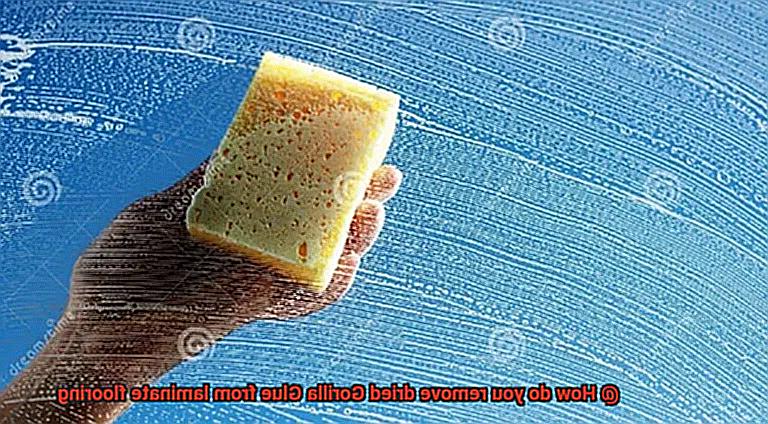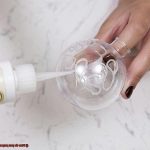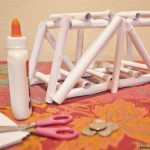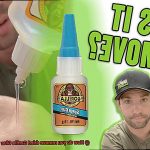Accidentally ended up with some stubborn dried Gorilla Glue on your lovely laminate flooring? Don’t panic, my friend. We’ve got your back with foolproof methods that will erase this sticky situation from existence. In this blog post, we’ll walk you through simple instructions to remove dried Gorilla Glue from your laminate flooring, leaving it flawless and free of any remnants of the glue mishap. Let’s dive right in.
How do you remove dried Gorilla Glue from laminate flooring?
Contents
- 1 How do you remove dried Gorilla Glue from laminate flooring?
- 2 What is Gorilla Glue?
- 3 Test Before Attempting Removal
- 4 Removing Dried Gorilla Glue with Acetone or Nail Polish Remover
- 5 Removing Dried Gorilla Glue with Isopropyl Alcohol
- 6 Removing Dried Gorilla Glue with Warm Water and Mild Dish Soap
- 7 Scraping Away the Dried Gorilla Glue
- 8 Using Heat to Remove the Dried Glue
- 9 Professional Help for Stubborn Spots
- 10 Conclusion
Method 1: The Acetone Magic Trick
First things first, crack open a window for some fresh air and slip into those protective gloves. Grab a soft cloth and slightly dampen it with a small amount of acetone. Gently dab the dried Gorilla Glue and let the acetone work its magic for a few minutes. Now, carefully scrape off the softened glue using a plastic scraper, making sure not to scratch your laminate flooring. Once done, wipe away any residue with a clean cloth soaked in warm, soapy water.
Method 2: Heat It Up.
For this technique, get hold of a trusty hairdryer and plug it in near the glued area. Switch it to high heat mode and direct the hot air onto the affected spot for around 2-3 minutes. The heat will soften that Gorilla Glue like butter, making it a breeze to remove. Once softened, gently scrape away the glue using a plastic scraper while being mindful not to apply too much pressure. Lastly, wipe off any remaining residue using a cloth dipped in warm, soapy water.
Method 3: Isopropyl Alcohol to the Rescue
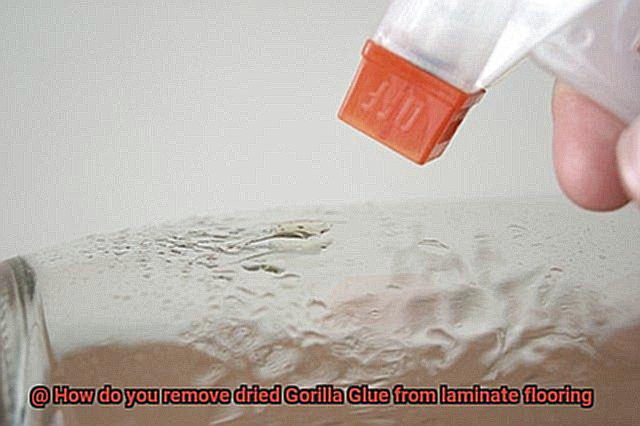
Safety first. Ensure proper ventilation by opening windows or working in an airy space, and don’t forget those gloves. Take a soft cloth and dampen it with a small amount of isopropyl alcohol. Gently dab the dried glue, allowing the alcohol to penetrate and break down the adhesive for a few minutes. Now, grab that plastic scraper and carefully scrape off the softened glue. Once you’ve successfully bid farewell to all traces of Gorilla Glue, wipe the area clean with a damp cloth.
Wrapping Up:
While Gorilla Glue may be known for its stubborn strength, removing dried glue from laminate flooring is not an impossible feat. Just remember to proceed with caution and choose the method that suits your situation best. By following
What is Gorilla Glue?
Gorilla Glue is not your ordinary adhesive. It is a force to be reckoned with, known for its unwavering strength and unmatched durability. This polyurethane glue has the power to bond together an array of materials, from wood to metal, stone to ceramic, and everything in between. No matter the task at hand, Gorilla Glue has got you covered.
Let’s talk about strength. Gorilla Glue boasts a bond that is two to three times stronger than your average adhesive. It’s the kind of bond that will stand the test of time, ensuring that your projects stay intact for years to come. Whether you’re tackling a DIY masterpiece or simply fixing something around the house, Gorilla Glue will provide the unyielding strength you need.
But that’s not all. Gorilla Glue has a secret weapon up its sleeve – its ability to expand as it cures. This expansion allows the glue to seep into every nook and cranny, filling gaps and creating a tight seal between surfaces. Cracks? No problem. Uneven surfaces? Consider them bonded. This adhesive is a master of precision, ensuring that your projects are flawlessly joined together.
And let’s not forget about its resilience. Gorilla Glue is waterproof and resistant to extreme temperatures, making it suitable for both indoor and outdoor applications. It can withstand moisture, heat, and cold without breaking a sweat. So whether you’re working on a project in your cozy workshop or braving the elements outside, Gorilla Glue won’t let you down.
Versatility is another feather in Gorilla Glue’s cap. It can tackle virtually any material with ease, making it a go-to adhesive for a wide range of projects. From repairing furniture to indulging in your favorite craft, from tackling home improvement tasks to exploring your creative side, Gorilla Glue is the ultimate tool in your arsenal.
But remember, with great power comes great responsibility. Follow the manufacturer’s instructions to achieve optimal results. Use Gorilla Glue in a well-ventilated area and protect those hands with gloves during the application process.
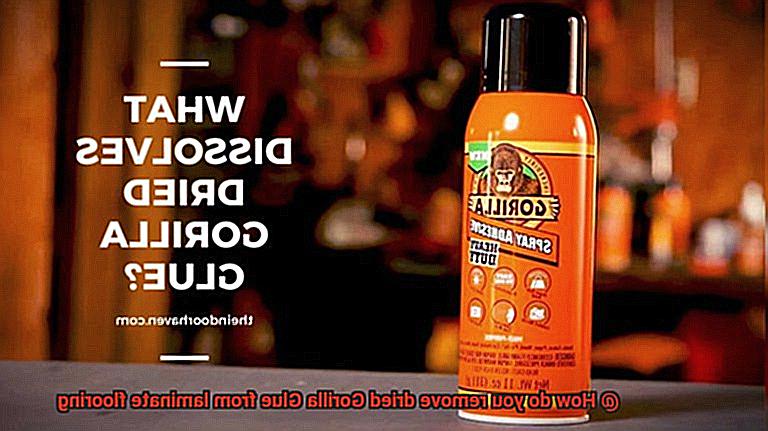
Test Before Attempting Removal
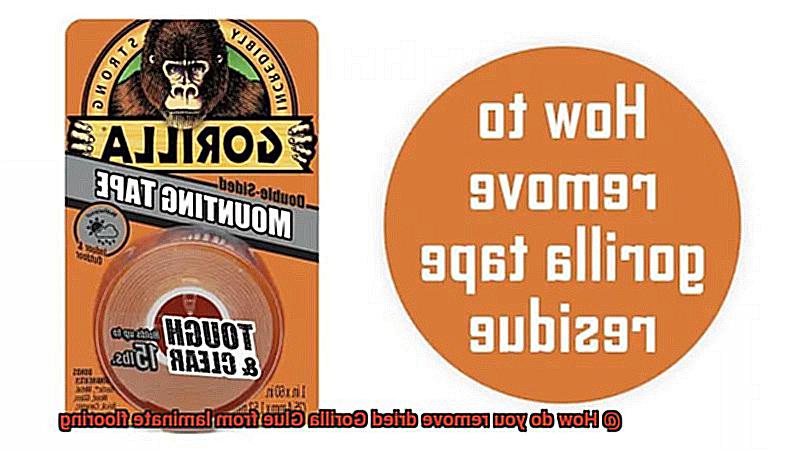
When it comes to removing Gorilla Glue from laminate flooring, caution is paramount. This powerful adhesive can leave behind stubborn residue that requires careful handling to prevent any damage to the flooring. That’s why testing the removal method on a small, inconspicuous area before diving into the full removal process is crucial.
Assess Effectiveness
Different types of laminate flooring may react differently to various cleaning solutions or removal methods. By performing a test patch, you can gauge whether the chosen method is effective for your specific type of laminate flooring. This saves time and effort by avoiding ineffective methods and allows you to find the most suitable solution.
Avoid Damage
Gorilla Glue’s high bonding capabilities make it challenging to remove once dried. Testing the removal method on a small area ensures that it won’t cause discoloration, staining, or other damage to the flooring. This step identifies potential adverse reactions before applying the method to the entire affected area.
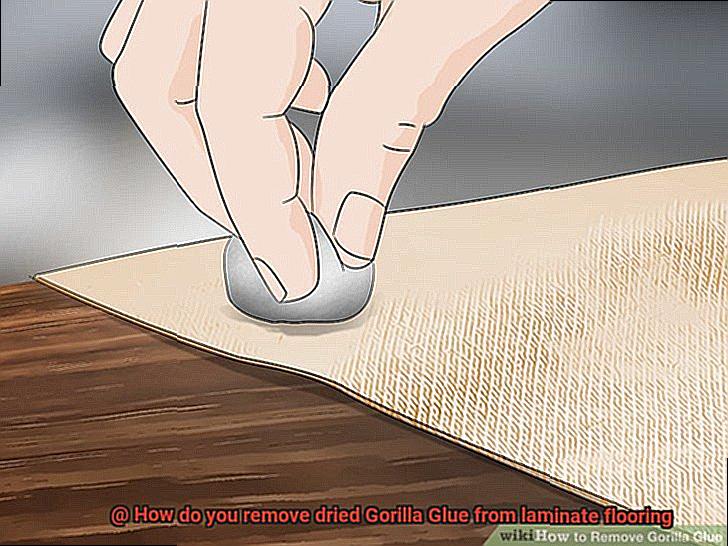
Safety First
Performing a test using a small amount of the cleaning solution or removal method on an inconspicuous area, such as a corner or underneath furniture or rugs, is crucial for safety purposes. By observing the effects on this test patch, you can determine if it is safe to proceed with the full removal process without risking any harm to your laminate flooring.
Removing Dried Gorilla Glue with Acetone or Nail Polish Remover
When it comes to liberating your laminate flooring from the clutches of dried Gorilla Glue, caution is key. This formidable adhesive can leave behind a stubborn residue that requires delicate handling to avoid any harm to your precious flooring. That’s why conducting a preliminary test on a discreet area before embarking on the full removal process is an absolute must.
Assess Effectiveness
Different types of laminate flooring may react differently to various cleaning solutions or removal methods. By meticulously performing a test patch, you can determine whether your chosen method is effective for your specific type of laminate flooring. This saves you time and effort by avoiding ineffective approaches and allows you to uncover the most suitable solution.
Avoid Damage
Gorilla Glue’s tenacious grip makes it a formidable foe when it comes to removal once it has dried. By subjecting your chosen removal method to a small, inconspicuous area during the testing phase, you ensure it won’t cause discoloration, unsightly stains, or other detrimental effects on your pristine flooring. This step serves as an early warning system, identifying potential adverse reactions before applying the method to the entire affected area.
Safety First
Prioritizing safety is essential when dealing with Gorilla Glue remnants on laminate flooring. Performing a meticulous test using a small amount of the cleaning solution or removal method on an inconspicuous corner or beneath furniture and rugs is paramount. Through astute observation of this trial patch, you can confidently determine whether it is safe to proceed with the full-scale removal process without jeopardizing the integrity of your beloved laminate flooring.
Removing Dried Gorilla Glue with Isopropyl Alcohol
Removing dried Gorilla Glue from laminate flooring can be a tricky task, but with the right method, it can be done effectively. One of the most commonly used solvents for this purpose is isopropyl alcohol, also known as rubbing alcohol.
Before diving into the process, it’s crucial to conduct a test patch on a small inconspicuous area of the laminate flooring. This step ensures that the alcohol won’t cause any damage or discoloration.
Once you’re ready to tackle the dried Gorilla Glue, pour a small amount of isopropyl alcohol onto a clean cloth or paper towel. You don’t need an excessive amount; just enough to dampen the cloth. Gently rub the affected area with the cloth, applying slight pressure to loosen the dried glue. Be patient; it may take some time and repeated rubbing to fully remove the glue. Remember to avoid using excessive force or scraping tools, as they can potentially damage the surface of the laminate flooring.
If the glue doesn’t come off completely with isopropyl alcohol, you can try using a plastic scraper or a soft-bristle brush to gently scrape or scrub off any remaining residue. However, be cautious and gentle to prevent any damage to the laminate flooring.
After removing the glue, wipe the area with a clean damp cloth to remove any traces of isopropyl alcohol and residue from the glue. Thoroughly drying the area is essential to prevent any moisture from damaging the laminate flooring. You can use a dry cloth or allow it to air dry completely before walking on it.
In case isopropyl alcohol doesn’t effectively remove the dried Gorilla Glue, there are alternative methods you can try, such as using acetone or nail polish remover. However, exercise caution and perform a test patch on an inconspicuous area first to ensure they won’t damage the laminate flooring.
Removing Dried Gorilla Glue with Warm Water and Mild Dish Soap
Removing dried Gorilla Glue from laminate flooring can be a daunting task, but fear not. With the right method, it is definitely achievable. One effective method is to use warm water and mild dish soap. Let’s dive into the step-by-step process of removing dried Gorilla Glue from laminate flooring using this method:
First, prepare the cleaning solution by filling a bucket or basin with warm water. Add a few drops of mild dish soap to the water and mix it well. Be careful not to use too much soap, as excessive residue can leave a film on the laminate surface.
Next, take a clean cloth or sponge and soak it in the soapy water solution. Wring out any excess liquid so that the cloth or sponge is damp but not dripping wet.
Gently scrub the dried Gorilla Glue on the laminate flooring with the soapy cloth or sponge. Apply gentle pressure and avoid scrubbing too vigorously, as this may damage the laminate surface. The warm water and soap will help soften and dissolve the glue.
If the glue is particularly stubborn, you can use a soft-bristle brush to gently scrub it off the laminate flooring. It’s important to choose a brush with soft bristles to avoid scratching the surface.
Once the glue has been successfully removed, rinse the area with clean water to remove any soap residue. This step is crucial to prevent any sticky residue from being left behind.
Finally, dry the floor thoroughly with a clean towel or mop to prevent any water damage to the laminate. Ensure there is no excess moisture left on the floor.
Remember, removing dried Gorilla Glue from laminate flooring may require some time and effort, especially if the glue has been dried for a long time. Patience and persistence are key. If the glue still remains after using warm water and mild dish soap, you may need to try other methods or consult a professional for further assistance.
Scraping Away the Dried Gorilla Glue
Scraping away the dried Gorilla Glue from laminate flooring requires careful attention and the right tools. To begin, gather the necessary materials: a plastic scraper or putty knife, a soft cloth, warm water, mild soap or detergent, and a gentle adhesive remover.
Start by gently scraping away as much of the dried glue as possible using the plastic scraper or putty knife. Take your time and be cautious to avoid scratching or gouging the laminate surface. If the glue is stubborn and resistant to scraping, try softening it by applying a warm cloth soaked in warm water over the affected area. Allow the heat and moisture to loosen the glue for a few minutes.
Once the glue has softened, resume scraping with the plastic scraper or putty knife. Proceed patiently and gently, ensuring you do not apply excessive force that could damage the laminate flooring. If remnants of dried glue remain after scraping, create a solution of mild soap or detergent mixed with warm water. Apply this solution to a soft cloth and gently rub it over the affected area, focusing on the remaining glue spots.
For more stubborn residues, test a gentle adhesive remover on a small inconspicuous area of the laminate flooring first to ensure it does not cause any discoloration or damage. Apply a small amount of the adhesive remover to a clean cloth and dab it onto the remaining glue spots. Allow it to sit for a few minutes to penetrate and break down the adhesive.
Once the glue has softened, use the plastic scraper or putty knife again to scrape away the residue. Be careful not to apply excessive force that could harm the laminate surface. After successfully removing the dried Gorilla Glue, thoroughly clean the laminate flooring with warm water and mild soap or detergent to remove any residue from the adhesive remover or remaining glue.
Using Heat to Remove the Dried Glue
Using heat to remove dried glue is a highly effective method for tackling stubborn adhesives. Whether you’re dealing with Gorilla Glue on laminate flooring or any other adhesive on various surfaces, the process remains similar. Here’s a detailed guide on how to use heat to remove dried glue:
- Gather your tools and prepare the area: Before starting, ensure you have a hairdryer or heat gun, a plastic scraper or credit card, and a clean cloth. It’s crucial to work in a well-ventilated area and remove any flammable materials from the vicinity.
- Start with low heat: If using a hairdryer, set it on low heat to avoid damaging the surface. For a heat gun, begin at the lowest setting and gradually increase if necessary.
- Apply heat evenly: Direct the hot air onto the dried glue, moving the hairdryer or heat gun back and forth to ensure even distribution of heat. The heat will soften and make the glue more pliable.
- Scrape off the softened glue: While heating the glue, gently lift and scrape off the softened adhesive with a plastic scraper or credit card. Take care not to apply excessive pressure or use sharp objects that may scratch or damage the surface.
- Use solvent if needed: In some cases, the glue may not soften enough with heat alone. If this happens, try using a solvent designed specifically for removing adhesive residues. Apply the solvent to a clean cloth and gently rub it on the glue until it begins to dissolve. Always test the solvent on a small inconspicuous area first to prevent discoloration or damage.
- Clean and dry: After successfully removing the glued residue, thoroughly clean the area with warm soapy water to eliminate any remaining residue or solvent. Finally, dry the surface with a clean cloth to ensure no moisture remains.
Professional Help for Stubborn Spots
Seeking professional help for stubborn spots caused by dried Gorilla Glue on laminate flooring can be a wise decision. Professional assistance offers expertise, specialized solvents and techniques, prevention strategies, accurate assessments, and time-saving benefits.
Hiring a flooring specialist or professional cleaning service with experience in adhesive removal ensures that you get help from professionals who have the knowledge and tools to handle the situation effectively. They understand different adhesives and can safely remove the Gorilla Glue without causing further damage to your laminate flooring.
Additionally, professional cleaning services may have access to specialized solvents or techniques specifically designed for removing tough stains and substances from various surfaces. These solvents can dissolve the Gorilla Glue effectively, restoring the appearance of your laminate flooring.
Professionals can also provide guidance on how to prevent future glue spills and offer advice on proper maintenance of laminate flooring. This helps you avoid similar problems in the future and keep your flooring in excellent condition.
When seeking professional help, it is crucial to communicate all necessary details about the dried Gorilla Glue situation. Providing information about the extent of the damage, any previous removal attempts, and specific concerns or requirements allows professionals to provide an accurate assessment and determine the most suitable approach for removing the stubborn spots.
Li3_SpYup18″ >
Also Read: How To Remove Glue From Laminate Flooring?
Conclusion
In conclusion, tackling the removal of dried Gorilla Glue from laminate flooring is no easy feat. But fear not, for with the right techniques and precautions, victory can be yours. It is absolutely essential to conduct a test on a small hidden area before proceeding with any removal method. This ensures that your laminate flooring remains unscathed and free from unsightly discoloration.
Prepare to witness the acetone magic trick in action. Armed with a soft cloth drenched in this powerful solvent, gently dab at the stubborn glue. Give it a few minutes to work its enchantment as it tenderizes the adhesive, making it a breeze to scrape away with a trusty plastic scraper. For those who prefer an alternative spellbinding solution, isopropyl alcohol can also work wonders in breaking down the glue’s hold.
Heat becomes your ally in another battle strategy. Unleash scorching air from a hairdryer or heat gun onto the hardened glue, rendering it malleable and ready for swift removal with either a plastic scraper or even a credit card if you so desire.
Should you wish to take a more soothing approach, warm water infused with mild dish soap can come to your aid. With gentle yet determined scrubbing using this concoction, watch as the dried glue dissolves and surrenders its grip on your laminate surface.
However, if these valiant attempts fall short of victory, do not despair. Seek professional assistance from esteemed flooring specialists or trusted cleaning services. These experts possess both the knowledge and specialized solvents required to eradicate even the most stubborn spots without inflicting further harm upon your beloved flooring.

